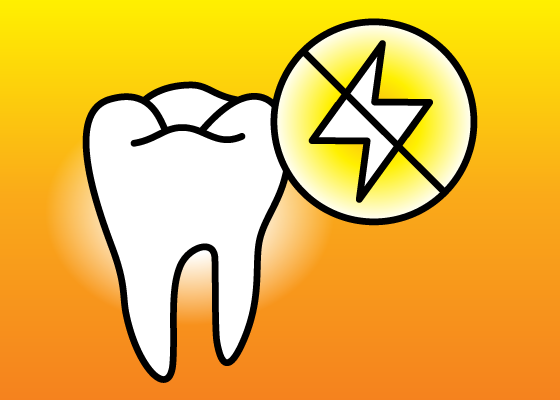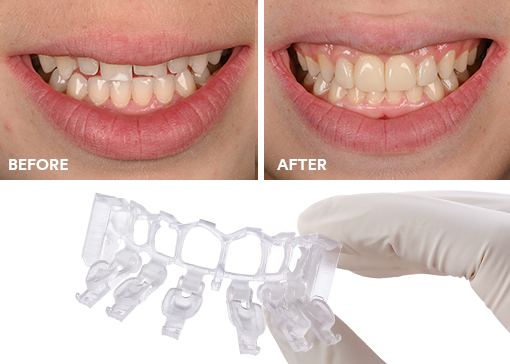Zirconia puzzle: what makes zirconia unique and how to choose the right zirconia
Zirconia may be part of your everyday vocabulary, but how much do you know about this ceramic material? Learn more…


Despite how far dentistry has come, post-operative sensitivity is still a common complaint after restorative procedures. However, there are steps every dentist can take to help reduce the risk. Discover how choosing the right adhesive system can help you achieve strong bonds – without the sensitivity.
Post-operative sensitivity is an adverse event following dental restorations with direct composite resin materials and adhesives. Early clinical studies showed that up to 30% of study populations reported post-operative sensitivity after placement of posterior composite restorations, which was usually attributed to using total-etch (etch-and-rinse) adhesives.1 As adhesive agents evolved from three-component etch-and-rinse systems (4th generation) to multi-mode, or universal adhesive agents, reducing the risk of post-operative sensitivity was always one of the desired outcomes.
While universal adhesives have been available since 2011, a meta-analysis published in 2015 still found an increased risk for spontaneous post-operative sensitivity in posterior restorations placed with total-etch systems.1 In this article, we will explore some potential causes for post-operative sensitivity in total-etch systems and present details on two multi-mode/universal adhesives – including studies on the long-term performance of 3M™ Scotchbond Universal Adhesive and recent data on 3M™ Scotchbond Universal Plus Adhesive.
The etch-and-rinse (E&R) adhesive strategy relies on removing the dentinal smear layer and demineralizing enamel and dentin through controlled application of 34-37% phosphoric acid. Acid-etching the highly-mineralized enamel results in a pitted appearance, providing mechanical micro-retention for adhesive solutions. However, acid-etching dentin, which is less mineralized and includes organic elements like collagen fibers, can result in collagen fiber exposure and the widening of dentinal tubules. After demineralization, a primer and adhesive are applied to the cavity walls to infiltrate the collagen fibers and dentinal tubules, to create what is known as the hybrid layer.
One of the main contributors to post-operative sensitivity in E&R systems is the adhesive agent failing to penetrate to the full depth of the exposed collagen layer and therefore failing to form a continuous interface and hybrid layer. In these cases, it’s common for the patient to complain of pain and sensitivity while chewing. However, checking the patient’s occlusal contacts often won’t reveal any primary contact points and may not reveal any occlusal contacts on the restoration at all. Confounding as this may seem, there is often no choice but to remove the restoration and begin anew. This, of course, creates a risk for unnecessary removal of healthy tooth structure, and requires more chair time, which is inconvenient for both practice and patient.
Some of the adhesive-based causes for post-operative sensitivity include the solvent in the adhesive evaporating prematurely, and the relative humidity of the collagen layer. Leaving the adhesive vial uncapped for longer than necessary or “forgetting” the adhesive in an unprotected mixing well can result in significant changes to the adhesive’s properties due to solvent evaporation and initial light polymerization. Choosing an adhesive with an inappropriate solvent or not correctly applying and activating the adhesive may also result in inadequate penetration between the collagen fibers or into demineralized dentin.
E&R systems are usually dependent on the relative humidity of the collagen layer, which is clinically difficult to define. This can result in either too moist or too dry an environment – both of which pose their own challenges for adequate hybrid layer formation.
In two-step E&R systems, the main function of the solvent in the combined primer-adhesive resin is to promote thorough monomer penetration into the collagen network of demineralized dentin.2 When bonding to air-dried dentin, the solvent should also be capable of re-expanding the collapsed network.3 Today, most two-step E&R systems rely on ethanol, ethanol/water, or acetone as solvents. While both ethanol and acetone are very good solvents, acetone evaporates about four times faster than ethanol, which can reduce the adhesive’s use life. In addition, acetone cannot re-wet or re-expand dried, collapsed, demineralized collagen. This means great care must be taken when using acetone-containing two-step E&R systems and dentin should be left moist (“wet bonding technique”).3 Since there is no clinical indication of the correct level of moisture on the demineralized dentin surface, an ethanol/ethanol-water solvent is preferable to acetone. Ethanol/ethanol-water-based adhesives, like Scotchbond Universal Adhesive and Scotchbond Universal Plus Adhesive, also allow for a longer use life.
The clinical objective of E&R systems is to ensure that the adhesive penetrates the deepest layer of demineralized collagen and creates resin tags in the dentinal tubules. In order to achieve this, ethanol/water-based adhesives should be rubbed into the dentin, much like shampooing hair, to ensure an even coating of collagen fibrils.4 That’s why the instructions for use for Scotchbond Universal Adhesive and Scotchbond Universal Plus Adhesive indicate the adhesive should rubbed into the cavity walls for 20 seconds, regardless of adhesive technique. For these adhesives, only one coat is necessary, as excessive adhesive coats can have an unnecessary thickening effect and may lead to lower bond strength.4
Upon comparing the bond strength of Scotchbond Universal Adhesive with a two-step E&R adhesive on etched moist and etched dry dentin, Perdigao et al. found that both adhesives created a well-demarcated hybrid layer on moist dentin. However, on dry dentin, only Scotchbond Universal Adhesive was able to create a hybrid layer, whereas the two-step E&R system could not “rewet” the collapsed collagen fibers.5 In addition, the microtensile bond strength of Scotchbond Universal Adhesive was not influenced by the mode of application. In fact, Scotchbond Universal Adhesive in self-etch mode showed statistically significantly higher microtensile bond strength when compared to leading self-etch adhesives.
Clinically, dentists may face varying degrees of humidity in the cavity itself. Using a rubber dam is considered good clinical practice and reduces the relative humidity in the cavity from between 78%-94% to that of ambient air.6 However, a survey of 229 dentists by Gilbert et al. found that rubber dams were used in only 12% of 9890 restorations.7 This creates a need for adhesive strategies that can be robust not only in the face of overdried dentin, but also in cavities where the relative humidity is high. Amsler et al. compared the effects of increased relative humidity and reduced application time on the shear bond strength of 6 different adhesives representing different adhesive strategies, including self-etch, etch-and-rinse, and universal/multi-mode. 8 They found that increased humidity had no adverse effect on the shear bond strength of Scotchbond Universal Adhesive.
Before the launch of Scotchbond Universal Adhesive in 2011, dentists had to choose between self-etch and etch-and-rinse strategies, often stocking more than one type of adhesive in their clinic to better accommodate different clinical needs. As the first multi-mode/universal adhesive on the market, Scotchbond Universal Adhesive was able to significantly improve adhesion, virtually eliminating post-operative sensitivity and providing clinically proven long-term adhesive strength, regardless of adhesive strategy.
In a post-marketing evaluation study, 75 dentists from 10 countries were asked to review patient files and report any incidence of post-operative sensitivity. 9 Over 144,000 restorations placed with Scotchbond Universal Adhesive, utilizing all adhesive strategies (self-etch, selective enamel etch, etch-and-rinse), were surveyed. The overall reported post-operative sensitivity was 0.8%, and sensitivity subsided over time. A limitation of this study is that there is no guarantee that all cases of post-operative sensitivity were reported by patients or recorded by the dentist. However, considering the number of restorations placed, the various adhesive strategies employed, and the number of dentists with varying experience, expertise, and clinical ability, these findings can’t be overlooked.
Upon its introduction in 2020, Scotchbond Universal Plus Adhesive’s potential for post-operative sensitivity was evaluated against its predecessor, Scotchbond Universal Adhesive, as well as other adhesives, in over 20,000 clinical applications in Germany and the US. 99% of dentists reported the same or less post-operative sensitivity compared to Scotchbond Universal Plus Adhesive.10
While in-vitro testing has merit, making sound clinical correlations from the results can be difficult due to the varying test methods and study sample sizes (which are usually just large enough to provide statistically significant results). Prospective clinical trials are of significant value in ascertaining the clinical robustness of new products. In a 5-year, randomized, blind clinical trial, 200 non-carious cervical lesions were assigned to one of four adhesive strategies using Scotchbond Universal Adhesive (self-etch, selective enamel etch, E&R moist, and E&R dry). 11 Restorations were evaluated after 5 years using FDI (World Dental Federation) and USPHS (United States Public Health Service) criteria. According to these criteria, retention rates after five years were 93% for E&R moist and dry, and 88.4% for selective enamel etch, at a 95% confidence interval. The retention rate for self-etch was 81%, which is in line with data provided in the literature. There was no difference in performance or retention between moist vs. dry etch-and-rinse, demonstrating that Scotchbond Universal Adhesive delivers a strong bond regardless of dentin moisture levels. It also showed high adhesive performance in restorations with little mechanical retention, regardless of adhesive strategy.
While three-component etch-and-rinse adhesives (4th generation) are considered the gold standard in adhesion, a clinical study comparing 3M™ Adper™ Scotchbond™ Multi-Purpose Adhesive (a three-component etch-and-rinse system) to Scotchbond Universal Adhesive, found no difference in marginal adaptation, secondary caries or sensitivity to cold.12 The retention rates after 2 years were:
• 87.6% for Scotchbond Multi-Purpose Adhesive
• 94.9% for Scotchbond Universal Adhesive (self-etch)
• 100% for Scotchbond Universal Adhesive (etch-and-rinse)
In addition, Scotchbond Universal Adhesive in etch-and-rinse mode showed significantly less marginal discoloration than the other groups.


The new Scotchbond Universal Plus Adhesive has also shown robust bond strength to both dentin and enamel, in self-etch and total-etch modes.13 Furthermore, Scotchbond Universal Plus Adhesive shows similar bond strength on caries-affected and sound dentin surfaces in both self-etch and total-etch modes. This indicates full resin infiltration, which creates the seal required to support minimally invasive techniques and the preservation of natural tooth structure.14
While post-operative sensitivity following dental restoration can occur, adhesive systems have evolved to help address sensitivity-causing issues associated with the bonding process, such as etching procedure, adequate adhesive penetration, solvent evaporation, and more. For example, as a universal/multi-mode adhesive, Scotchbond Universal
Adhesive has established itself as a robust adhesive solution that not only reduces the risk for adhesive-related post-operative sensitivity, but also facilitates documented in-vitro and published clinical success, regardless of adhesive strategy used, with results comparable or better than gold standard three-component etch-and-rinse adhesive systems. The newly launched Scotchbond Universal Plus Adhesive continues in this tradition, allowing clinicians to better their bond strengths with the confidence of virtually no post-op sensitivity. By taking advantage of these modern adhesive options, namely universal/multi-mode adhesives, dentists can achieve strong bonds without sensitivity – a win-win for dentists and patients alike.
References:
1. Reis A, et al. Dent Materials 2015;31:1052-1067.
2. Nakajima M, et al. Dent Materials 2002;18:603-8.
3. Van Landuyt L, et al. Biomaterials 2007;28:3757-3785.
4. Silva E Souza Jr MH, et al. J Appl Oral Sci 2010;18:207-14
5. Perdigao J, et al. Am J Dent 2012;25:153-158.
6. Plansmans PJ, et al. J Dent 1993;21:228-233.
7. Gilbert GH, et al. Oper Dent 2010;35:491-499.
8. Amsler F, et al. J Adhes Dent 2015;17:249-256.
9. 3M OCSD Post Marketing Evaluation Study, Internal Data.
10. 3M OCSD Data on File
11. Loguerico AD, et al. Dent Materials 2020;36:1474-1485
12. Lawson NC, et al. J Dent 2015;43:1229-1234.
13. Schuckar M, et al. J Dent Res 98 (Spec Iss B), No. 0444, 2019
14. Thalacker C, et al. J Dent Res 99 (Spec Iss A), No. 0191, 2020

Zirconia may be part of your everyday vocabulary, but how much do you know about this ceramic material? Learn more…

Achieving the correct shape is vital to a natural-looking anterior composite restoration. Learn how the 3M™ Filtek™ Matrix, paired with…

Direct composite restorative procedures can be challenging, particularly when it comes to esthetic cases. Discover how new techniques and tools…